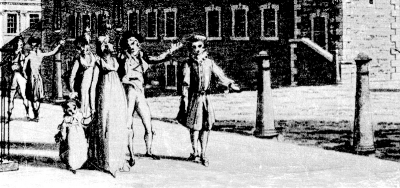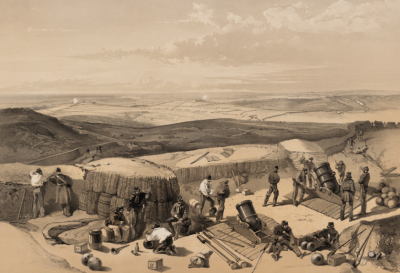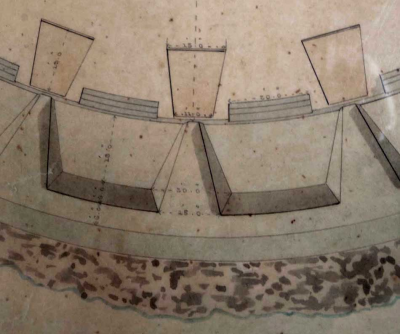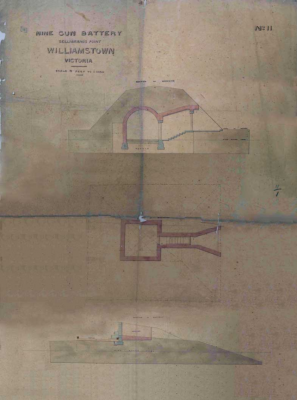Independence from New South Wales and the right to separate governance was granted to Victoria in July 1851. At the time of arrival of Sir Charles Hotham as replacement Lieutenant-Governor on December 6th 1853, the Victorian Legislative Council, his advisory body, was a partially appointed and partially elected group of thirty men. One of the principal questions confronting all Australasian colonies about Britain’s impending war with Imperial Russia was how to protect themselves from a raid by a Russian cruiser or naval squadron. In the Council Chamber on January 27th 1854, pioneer Melbourne settler John Pascoe Fawkner presented the following motion:
That it is expedient to prepare an address to His Excellency the Lieutenant-Governor to put upon the supplementary estimates a sum of money sufficient to provide the necessary weapons, artillery, men, and munitions of war that may be thought requisite safely to defend this province from aggression, and to take all the necessary steps that this important interest may require.
The ensuing debate centered upon the exposed position of the city of Melbourne and it appeared that almost every participant had a separate plan for its defence. Some proposed fortifying Port Phillip Heads, a measure others declared to be useless. Some were for mooring steam-frigates in shipping channels, others for increasing the strength of the regular garrison troops, and others for forming a citizen militia. The result of their deliberations was the carrying of an amendment presented by Captain Dane, to appoint a Select Committee that would sit behind closed doors to establish locations liable to attack by an enemy and to consider the colony’s existing means of defence. The Colonial Secretary’s view was that:
…there was not much danger to be apprehended from the visit of a hostile armament to the shores of Port Phillip from either France or Russia. When they considered the enormous expense of sending a large fleet of vessels of war across the whole globe, they would see that, whatever temptation their riches might offer to a small flotilla of privateers, there was not much to fear from an array of large ships of war.
The recommendations of the Committee were that the 40th Regiment of Foot should be immediately increased to the establishment of a full corps in the East Indies and stationed solely in Victoria while four hundred discharged soldiers were being sought from Great Britain, in the proportion of one hundred artillerymen to three hundred infantry. They also urged that immediate application be made for a steam paddle-warship similar to Her Majesty’s sloop Devastation, to be stationed at Port Phillip; plus the acquisition of a battery of field artillery, made up of six nine-pounders and two 24-pounder howitzers to be obtained by purchase from the Royal Arsenal at Woolwich. The British Parliament and Admiralty view was that all available resources were being mustered for an Anglo-French action in the Crimea, and therefore, they were unwilling to immediately increase the number of British troops or naval vessels stationed in the Australian colonies. However, they agreed to allow the formation of Militia forces in each colony. As a result, Charles Hotham approved an Act to establish a Volunteer Corps not exceeding 2,000 men, its officers to be appointed by him. The Australian colonies in unison pressed for the provision of artillery pieces and proceeded to upgrade or construct harbour fortifications to guard the principal ports.
The Imperial response in early 1855 was to despatch twenty 32-pounder cannons to Port Phillip and another twenty 32-pounders to Sydney, at no cost to the colonies. This appears generous given their need to protect British naval and home ports and supply Royal Navy requirements, plus, equip the expeditionary forces with siege guns for the war with Russia. However, at least some of the cannons that arrived at Port Phillip dated back 150 years to the joint reign of King William III & Queen Mary II (1689-1702).
The clipper ship Aerolite arrived at Port Phillip on July 21st 1855, with the 32-pounders and the Geelong Advertiser & Intelligencer stated that six guns and a stove and rack for heating shot were taken ashore at Sandridge on September 19th.
The thirty-two pounders on the Sandridge jetty are of tried virtue. They were cast in the reign of William and Mary, and did great execution at the Battle of Blenheim (1704). They were then kept in the Tower for many years, but were again called into use at the siege of Quebec (1775). They also were used by Wellington in the Peninsular (1808-1814), and on the return of peace were stuck up as corner posts in Portsmouth Dockyard. They were taken up by order of the Ordnance department, and shipped to this place as eminently adapted for colonial use. It is said that since Mr Childers has become Captain of the Artillery Company, the insurance offices have refused to grant him a policy on his life at any premium. Three of the guns are in much better order than the others, having been wrecked in the Royal George (1782).

Given their age, these six guns may have been ‘light’ 25-cwt, SB 32-pounder s, and they were soon described as useless at the range required from the simple gabion battery being constructed at Sandridge Beach. On the 24th September, The Argus newspaper reported that at Point Gellibrand, Williamstown, six 32-pounders, 7 feet and 6 inches in length, and weighing 46-cwt each ‘were already on their carriages, but are, as we are informed to be placed on traversing platforms, adding greatly of course, to their means of commanding the bay. Behind these guns and a short distance from the lighthouse, will be erected a magazine, arched with stone, and rendered shot and bombproof’.
The Williamstown guns were probably cast at the Carron Company works around 1811. According to the Sydney Morning Herald, the remaining heavy guns were to be placed aboard the former water police vessel, Sir Harry Smith, which for four years had been anchored near the Williamstown shore as a hulk, and was now to be refurbished and anchored to act as a block ship on the St Kilda side of Hobson’s Bay.
Captain Charles Pasley RE had arrived at Port Phillip in 1853 to take on the role of Colonial Engineer of Victoria. In 1854 when news of the declaration of war on Russia reached the colony, he was given the task of designing two gun batteries for defence of the anchorage at Hobson’s Bay. The simpler of the two was a six gun gabion battery at Sandridge. This was constructed close to the beach on what is now the intersection of Kerferd Road and Beaconsfield Parade, South Melbourne. Military gabions were circular wickerwork cages filled with stone or earth, and were the principal form of protection used on the inner face of gun batteries built at the siege of Sebastopol, Crimea, in 1855.

On September 8th 1855, the Melbourne Herald reported that ‘a party consisting of 25 men of the 12th Regiment left their Melbourne quarters yesterday morning for Sandridge, to assist in the structure of a six gun gabion battery, about to be erected on the beach, in such a position as to be able to co-operate with another at Gellibrand’s Point’. Given the simplicity of the battery at Sandridge there is little likelihood that Pasley produced a set of new drawings, and instead relied upon standard Royal Artillery reference guides of the day covering the construction of field works. It remains unclear if miners & sappers were attached to the elements of the 12th Foot Regiment allocated to Victoria in 1855, or he simply utilized soldiers who were fit and available. In November 800 members of the 40th Regiment of Foot disembarked from the transport ship Windsor to relieve the 12th, who then departed for Van Diemen’s Land.
The sandbars and shallow waters located off the beach at Sandridge it was impossible for an attacking force to steam within a mile of the Sandridge battery, so a battery constructed from gabions and earth would provide sufficient protection for its guns. However, the situation with any battery to be constructed at Gellibrand Point was far more complex. Off Williamstown the mouth of the Yarra River continually scoured a channel that ran parallel to, and within half a mile of, the shoreline. A far more robust structure was necessary and Pasley set about providing drawings for a stone and earth nine gun battery with a protected powder magazine. Until the author happened across these two drawings in a previously ‘uncleared’ folder held in the National Archives of Australia (NAA) collection at Burwood, there were only newspaper accounts to describe this significant fortification.
Lieutenant-Governor Sir Charles Hotham visited Williamstown in May 1855 accompanied by Pasley as Colonial Engineer along with the Inspector-General of Prisons, and the Chief Harbour Master, Captain Ferguson. Their immediate task was to examine works being carried out by convict labour. But according to The Empire, fortification of the bay was also apparently occupying the very serious attention of Sir Charles, who had under contemplation, a fort at Gellibrand Point, a gun battery on the Sandridge shore, and a properly mounted blockship. News of the arrival of the expected 32-pounder guns led to an immediate commencement of the proposed earthwork at Sandridge beach, closely followed by preparation of a shoreline site near the lighthouse for the Williamstown defence structure.
By late-September The Argus was describing the foundation works as:
A strong embankment of broken stone thrown out into the water (and) assuming the form of the whole work. (Semicircular) This is raised to high water level. Inside the embankment will be placed a second one, of clay, so as to prevent the permeation of the tide and in the cavity thus formed will be laid a solid foundation of heavy stone which will also be covered with a puddle flooring of clay, the whole forming a foundation of immense strength, and rising just above high water mark…
While the embrasured battery to be constructed above the substructure would be:
…a strong earth-work, that material as experience has proved, being best capable of withstanding the action of cannon shot. The parapet will be seven feet high, eighteen feet wide at the summit, and twenty-six feet wide at the base, giving its exterior slope a fall of nearly fourteen inches to a foot. This will or course, be riveted, not only to prevent its being loosened by the shot of an assailant, but also to prevent the risk of an earth slip from the concussion of its own guns. Within the works the parapet will be made nearly perpendicular, and the whole of the interior will be faced with stone.
While the Point Gellibrand battery was described in considerable detail in contemporary newspaper reports, little information has been available about the magazines structure. Plan No. I of the Pasley drawings found at NAA Burwood now provides us with a clear understanding of its form and measurements.

Point Gellibrand redoubt was constructed over a deep bed of “puddle” rising 5-ft above high water level; it had an interior radius of 138-ft. (Puddle was A mixture of wet clay and sand that is impervious to water when dry and can be used to line and waterproof a structure.) The interior wall was constructed of basalt blocks around 16-inches thick which had been carved by convict labour at the nearby quarries. It rose to a maximum height of 8-ft, although the gun embrasures were barely 3-ft in height, and beneath the covering of turf were lined with 12’ 6” of brickwork on the exterior slope to reduce blast damage from the 32-pounders.
The detail below illustrates the extremely narrow field of fire for each gun, which led to the rebuilding of the Point Gellibrand bastion during the 1860’s so that greater lateral gun movement could occur.

The interior of Point Gellibrand Magazine was a 12-ft square chamber, sitting atop a basalt foundation and enclosed in brick walls 2’ 6” thick supporting an arched brick vault. Its chamber floor was 5-ft below ground level and 5-ft above high tide level.

The entirety was buried beneath a pyramidal shaped earthen mound, approximately 35-ft by 45-ft at ground level. Entry was made via a funnelled opening on the eastern face which linked to a sloping passage containing six basalt steps and enclosed by doors at either end. The stone floor was covered with cowhide to prevent ‘sparking’ igniting any uncontained gun powder.
The Argus explained who built the fortifications:
These large operations have been executed without a single paid citizen being engaged; in short by the convicts of the ‘Success’, ‘Lysander’ and ‘Sacramento’, lying near the spot. Nor is this all, the stone destined for the erection of the Geelong Jail lies at the quarries, hewn into its proper shape, and requiring nothing but removal and setting up upon the spot for which it is destined. The stonework, we may state from personal observation is exceedingly well finished, and the structure when erected will be of a solid character, and not altogether unornamental. At the quarries is a smiths shop and forges erected of brick and stone, also by convict labour, and in this edifice it is intended to execute any ironwork that may be required for the redoubt, the piers, and the jail.
While the battery was undergoing construction the Victorian Government passed legislation to establish a Victorian Volunteer Artillery Regiment. Years later the Williamstown Chronicle reported that on June 9th 1856, Captain Ferguson was informed that Lieutenant Colonel Anderson had recommended he be appointed as a Captain in the regiment, in order to establish a Marine Artillery Company at Williamstown, and, that he was at liberty to take any measures he may think fit for the formation of the same, reporting progress to this office from time to time.
The company came into existence on June 26th 1856 and within two months had a membership of seventy men. However, attendance at drill apparently faltered soon after official uniforms had been issued, so that by year’s end, only a half muster was in regularly attendance. Six months after its inception George Frederick Verdon (later Victoria’s Treasurer) was appointed Acting Adjutant of the company. For a brief period it thrived under his leadership, although one volunteer described him as having:
…a failing common to many of the juvenile portion of the ‘genes Homo’, viz. haughty and domineering, which in a very short time showed itself in a dead-lock ensuing between the Company’s Committee and that gentleman, and Mr Verdon, in a fit of sulkiness, resigned his connection with the Division.
Apparently, the leadership of the company fell back to Captain Ferguson, who, although extremely well liked by the volunteers, was frequently absent in going about his maritime business. A letter to the editor of the Williamstown Chronicle in September 1857 stated there were only 48 members listed on the roll, the worst having been ‘struck-off’. The writer went on to say that although fourteen months had passed, no commissioned officers had been elected as Lieutenants and some positions for non-commissioned officers remained unfilled. His final grievance was that there had not been a commanding officer’s parade since the corps was established; with the consequence that one-half the people of Williamstown did not know there was a Volunteer Corps in existence.
In July 1858 a Royal Commission on the defences for the colony of Victoria was established. Its findings led to a request for a Royal Engineer expert in fortifications to be sent to the colony to advise the government on its future defences. The arrival of Captain Peter Scratchley R.E. from India in June 1860 would be the catalyst for a second stage of defence construction at Hobson’s Bay.
Contact Keith Quinton about this article.






